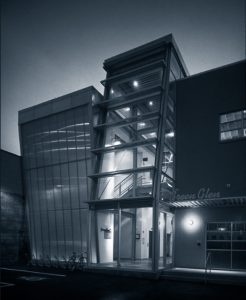
While walking briskly to our late lunch to discuss the subject of time and technology, Peter Pfau pauses mid-sentence to answer his cell phone. Negotiating a mutually acceptable meeting time for later that day, he reaches into his jacket and takes out his Palm Pilot, with his calendar hot-synched from the office computer, and makes a quick note. As we cross the street he picks up our conversation exactly where he left off.
Peter Pfau is the principal of a 20-person office located in San Francisco’s South of Market district. The firm is known for high-tech work that experiments with materials and details. It has also gained a reputation for collaboration with other disciplines (graphic arts, for one), especially after its two highly successful Swatch Pavilions in Atlanta and Lisbon. There are currently 22 active jobs in the office. Asked about his practice. Pfau replies.
“It’s so time-impacted it’s insane.” He admits that is partly due to the large number of projects but mostly can be attributed to the speed demands clients. and the marketplace, put on the architectural process. Pfau says that in one way or another, every one of his jobs is fast-track.
The office has been substantially computerized for the past seven years, and Form Z has become a powerful tool. “The problem with computers,” Pfau asserts. “is that it looks like you’re done when you’re not. The modeling is convincing, but we still don’t really know what it is. There is no real sense of materiality.” Buildings still have to be worked out at the details level. And Pfau’s office still uses physical study models, drawings and other ways of working that are more conventional than computers.
Expressing some reservation, Pfau comments on the latest thing with computers in practice: having a Web site serve as a project clearinghouse. While this has the salutary effect of centralizing all information, documentation and communication, he expects it will also cause the allotted request for information time in contracts to be reduced, thus further compressing the process.
Additional expectations are being created by technology: greater accessibility, shorter turnaround time on every phase of the delivery of architectural services. Increasingly, Pfau’s clients are asking for (he attempts to resist) a liquidated damages clause in contract negotiation, hoping to transfer much of the financial risk to the architects and consultants. Time is, insistently and for all involved, money.
Another reality of practice is liability anxiety. Pfau points out that it would be useful to have a standard AlA contract for fast-track projects that acknowledges the higher cost of preparing overlapping permit and construction drawing sets. One is needed, he says, that would factor in the dramatically increased liability that coordinating such projects entails.
A lawyer now negotiates all contracts for Pfau Architecture.
The former partner of Holt Hinshaw Pfau Jones has decided to keep his firm at 20 people. He negotiates fees based on person-power allocations in relationship to the scope of work. He gives his staff the trust and responsibility to do the work by themselves and takes pride in the fact that they stay with him for long periods. “I am trying to hang onto humanity in the office,” Pfau says with a shake of his head. “I want my people to have a life. I want staying late to be the exception and not the rule. To be any good at this, we all have to have experiences other than sitting at a desk. It’s got to be fun, or it’s just not worth doing.”
The world, clients and employees verbally communicate with Pfau primarily through voice mail at the office and voice mail on his cell phone, not to mention the old-fashioned queuing at his desk (most interoffice conferring is on a casual basis). Typically, when he checks midday, there are 18 phone messages—and 10 to 12 e-mails—waiting for him.
To attempt to manage the communication flood, Pfau is centralizing his voice mail to his office phone and is considering setting up a time to return calls, as doctors and lawyers have done for years. He is also contemplating “meeting- free” zones for his calendar, when he cannot be scheduled into the myriad of confabs that inundate his days.
On the personal side, Pfau and his family have recently moved to Marin County, creating a commute time of up to an hour each way (during which he makes phone calls, naturally). Since he became a parent. his old safety valve of staying up all night is gone. However, having a house that needs a lot of work and a two-year-old waiting for him when he walks in the door helps him switch gears. “When I’m on duty, I am intensely engaged with my practice,” he says. “And when I’m off duty, I’m able to turn it off.”
In the end, what worries Peter Pfau is that all the time issues become one more in the set of forces that steadily work to drag architecture into mediocrity. “I think people are starting to react against all of this,” he says as we start back from lunch. “They’re starting to set up barriers and boundaries.” The cell phone rings again. It’s his wife, Kim, reporting on digging up a nest of lizard eggs in the yard that they are turning into a garden.
Originally published in early 2000, in arcCA 00.1, “Zoning Time.”





